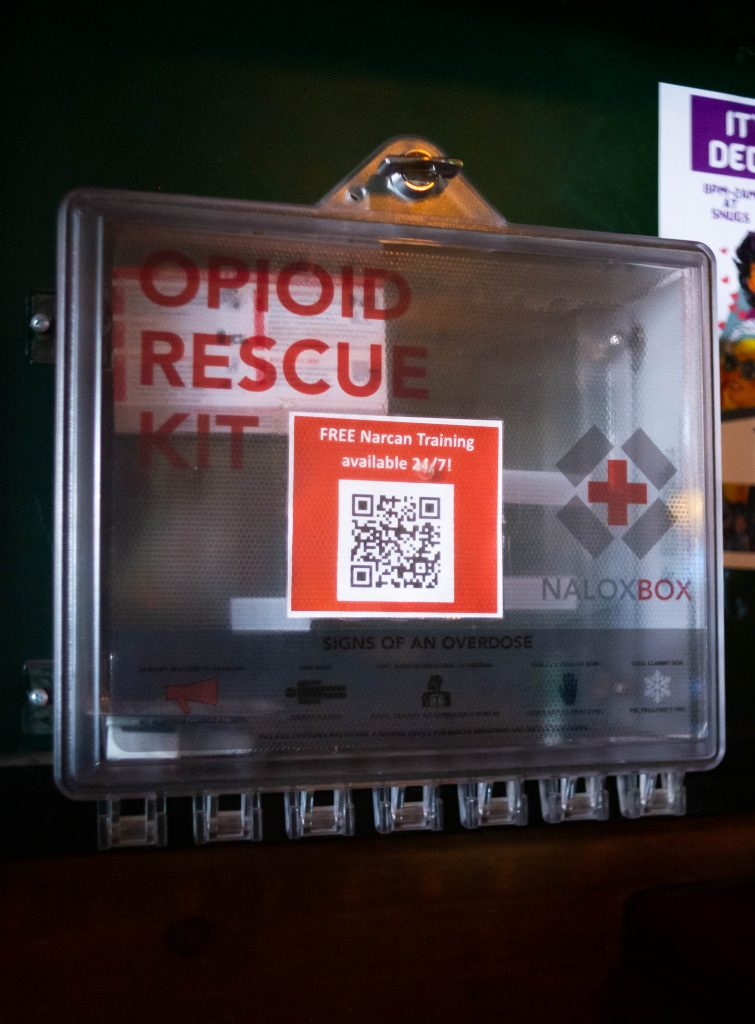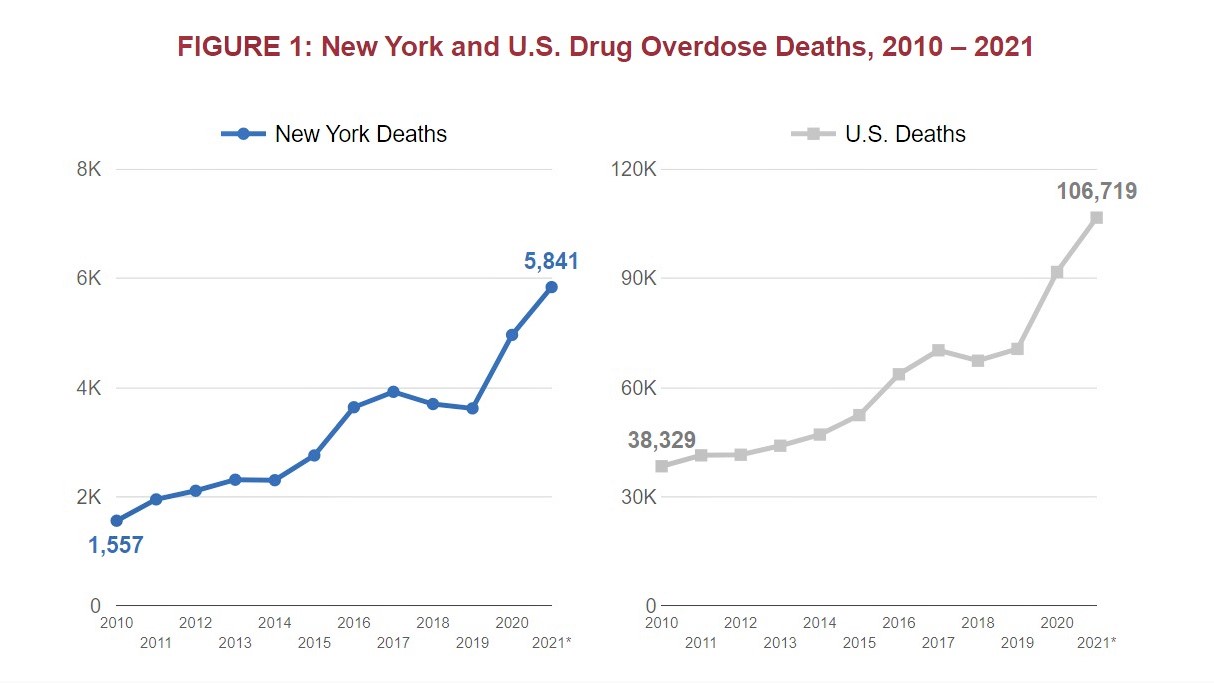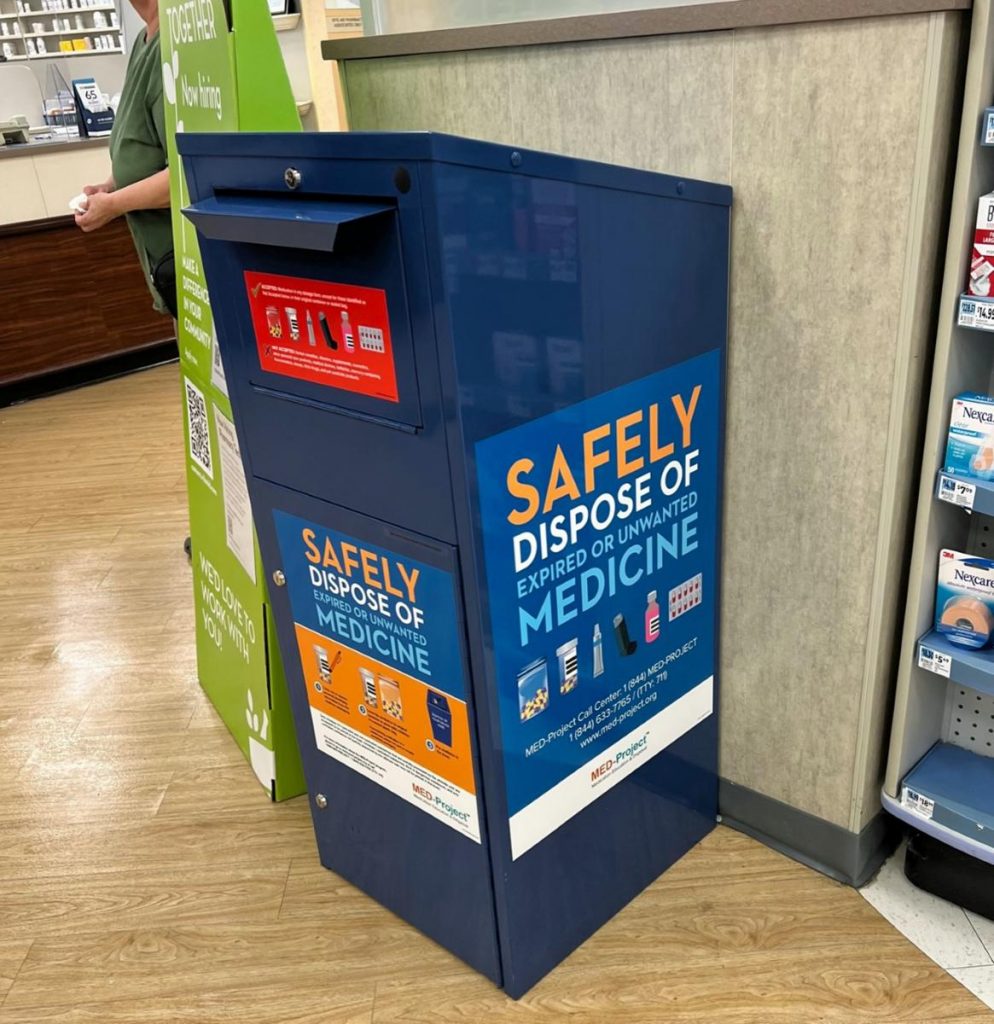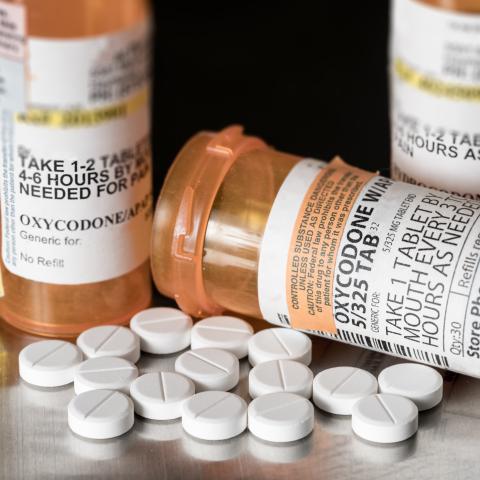
Since August 2022, DEA and other law enforcement agencies nationwide have seized brightly-colored fentanyl and fentanyl pills in 26 states. Dubbed “rainbow fentanyl,” this trend appears to be a new method used by drug cartels to sell highly addictive and potentially deadly fentanyl made to look like candy to children and young people.
As opioid related deaths continue to skyrocket across New York, many are left wondering what can be done to solve this problem. State and local leaders face some tough decisions on how to combat the opioid epidemic. Elected officials acknowledge that, just as there is no single reason why addiction is climbing, there is no one solution to the crisis.
An analysis documenting the current effects of the ongoing opioid-related public health crisis was released November 1 by State Comptroller Thomas DiNapoli.
The findings of the study are alarming — a 68 percent increase in opioid-related overdose deaths in just the last three years, with 5,841 deaths in 2021 alone.
New York and the rest of the nation are now five years into a nationwide opioid public health emergency, first declared in October 2017 by the federal government and renewed 20 times since.

The comptroller’s report notes the federal government this year issued a new comprehensive strategy to address drug overdoses, and New York and other states are receiving new resources from settlements with opioid manufacturers, distributors and others that provide an opportunity to bolster efforts to prevent abuse, support treatment and reduce harm to prevent as many drug overdose deaths as possible.
Because of privacy laws and other statistical reliability concerns, U.S. Centers for Disease Control data are only available for certain New York counties. But in those counties with available data, drug overdose death rates more than doubled from 2010 to 2020.
Dutchess County had the overall highest overdose death rate in 2020, at 43.3 per 100,000 residents, up from 18.2 per 100,000 residents in 2010.
Niagara County saw the biggest jump in overdose deaths, rising from 12.8 deaths per 100,000 residents in 2010 to 39.1 deaths per 100,000 residents in 2020.
The current statewide average is 18 deaths per 100,000 population each year.
Bronx County’s death rate rose from 8.3 in 2010 to 38.7 in 2020. Monroe County rose from 7.9 in 2010 to 36.7 in 2020. Onondaga County went from 9 to 35.9 in that decade; Erie jumped from 8.9 to 32.1; Suffolk from 13.2 to 30.3; and Albany County from 8.6 to 28.6 in that time period.
The comptroller’s report also shows that the total fatalities and death rates among black or African Americans statewide increased about five-fold from 2010 to 2020, while total deaths and death rates among whites nearly tripled. In addition, fatalities and death rates among Hispanic and Latino New Yorkers quadrupled.
“Fatalities grew across all racial and ethnic groups, death rates for all drug overdoses increased fivefold for Black New Yorkers, quadrupled for Hispanic or Latino New Yorkers, and nearly tripled for White New Yorkers,” said DiNapoli.

Research generally cites a number of reasons for the use of illicit drugs and misuse of medications: coping with mental health problems and stressors such as adverse childhood experiences and relationship problems; pain relief for a legitimate medical issue that resulted in unexpected intoxication; and experimentation or the desire for a novel psychoactive experience.
New York’s opioid crisis has been accelerated due to a rise in fentanyl use — a highly fatal and addictive substance drug traffickers are mixing with other illicit drugs due to its low price point.
New York’s opioid problem is tied to a larger national issue dating back to October, 2017 when the U.S. Department of Health and Human Services declared the opioid epidemic a national public health emergency.
DiNapoli addressed his data at a recent press hearing live from Thrive Recovery Community and Outreach Center on Long Island.
“Too many New Yorkers have died from the misuse of drugs, but the jump in these numbers is alarming. It is a tragedy that devastates families and impacts our communities in countless ways,” DiNapoli said. “The data shows our battle against drug overdose deaths is far from over. State leaders must ensure an ongoing commitment of public resources and strategies, including new funding from legal settlements, and innovative, evidence-based solutions for the fight against this deadly epidemic to be effective.”
The opioid crisis is an ongoing national issue. It is fair to say that New York is suffering severely with statewide death rates exceeding the national average in both 2021 and 2022. The data shows opioid death rates in 2021 increased by 44 percent in New York and 38 percent nationally – New York ahead of the national average by 6 percent.
Ulster County Sheriff Juan Figueroa spoke with the Gazette about this issue stating that the state needs to facilitate resources focused on training and awareness.
Figueroa has been fighting this epidemic since 2019 spearheading the Opioid Response as County Law Enforcement (ORACLE) – An Ulster County crisis-intervention and recovery response program using social workers and crisis intervention teams intended to rehabilitate, not jail those affected by the epidemic.
“We embedded social workers, peer advocates, case managers and we get reports from every agency in the state when there’s an overdose and we go within 24 hours and we try to get these folks into rehab,” Figueroa said.
Figueroa told the Gazette the goal is to eliminate the fear of being prosecuted under the law and encourage those witnessing an overdose to seek help immediately. “There was a time when they wouldn’t even call 911 because they didn’t want us to show up because they were afraid they were going to be arrested,” said Figueroa.

One of the many medical safety deposit boxes placed by the Ulster County Government in an effort to keep medication out of the hands of those who may abuse it.
SUNY New Paltz, in Ulster County, has been ahead of the curve, promoting education and training for many years, and provides resources to students and staff such as free Narcan training to help individuals recognize the signs of an overdose and train attendees on how to safely administer the overdose reversal drug, naloxone.
Jaclyn Cirello, the coordinator of Wellbeing Initiatives & Outreach at SUNY New Paltz, oversees alcohol and substance issues in the campus community. She notes that SUNY New Paltz has worked closely with Figueora to certify every University Police Department officer as an official ORACLE responder through the Sheriff’s office.
SUNY New Paltz provides a number of services including frequent Narcan training sessions; delivery of Narcan kits; medication return and disposal; treatment resources; and recovery support. The college offers virtual live Narcan training which runs monthly – the last Friday of the month. The college also holds 24/7 web-based and over-the-phone training sessions. All who participate in these trainings are eligible to receive free Narcan kits either by pickup at specific locations or by mail.
“All students attending first year and transfer orientations are told about Narcan training and other resources. Narcan trainings are also promoted in other trainings include CPR and First Aid,” Cirello said.
During the 2021-2022 academic year, SUNY New Paltz conducted seven virtual trainings and eight pop-up trainings with a total number of 172 attendees trained including Resident Assistants.
Other colleges will soon be implementing similar training sessions. A new law signed by Gov. Kathy Hochul in October (S.3448A/A.4485B) now requires campuses to carry lifesaving opioid antagonist medications in their housing units, as well as training Resident Assistants to be administers during overdose emergencies. The bill was sponsored by Sen. Michelle Hinchey, D-Saugerties, and Assemblyman Danny O’Donnell, D-Manhattan.
“Every second counts during an opioid overdose, and by requiring Narcan in all SUNY and CUNY housing, with trained student RAs on standby, we will save more young lives and transform on-campus safety,” Hinchey said.
Another advocate who has been working alongside Figueroa to combat the Hudson Valley’s fentanyl and opioid crisis is newly elected Congressman, Pat Ryan, D-Gardiner.
Ryan spoke of his efforts pre-pandemic as the Ulster County executive wherein he reduced the total number of fatal opioid related deaths across Ulster County by 40 percent.
“A lot of what we did in that first period are things that we need to ramp up and get more resources behind,” said Ryan, stating that his efforts to continue to combat the opioid crisis are rooted in bringing his efforts in Ulster County to a larger, national scale. Some of his past efforts include declaring a public health emergency for fentanyl in Ulster County, partnering with Sheriff Figueroa to creat the ORACLE program, and working with other officials to facilitate the largest drug bust in Ulster County history.
The Gazette asked Ryan how he planned to further fight this crisis using his newly obtained national platform as Congressman of New York’s District 18. “What’s exciting is that I’ve already been able to get back to work on the issue in DC,” said Ryan.
Ryan secured several million dollars for Ellenville Regional Hospital – a process he started as Ulster County Executive and followed through to his term as a Congressman. “With that grant we are able to expand initiative ORACLE and increase collaboration with law enforcement and the community” said Ryan. The grant will also work to increase the distribution of Naloxone and increase the number of mental health professionals working in Ulster County.
Ryan also emphasized the importance of stopping Fentanyl from entering the community – stating that an increase in funding for law enforcement will be needed if we wish to make a difference. “We have to recognize the serious threat of fentanyl,” said Ryan, who currently co-sponsors a bill called the Securing America’s Border Against Fentanyl Act (H.R.8316) originally proposed by Congresswoman Abigail Davis Spanberger of Virginia.
The Securing America’s Border Against Fentanyl Act (H.R.8316) works to aid the Department of Homeland Security in all drug interdiction efforts along the border including locating illicit fentanyl and other harmful substances such as counterfeit pills by increasing data collection efforts in order to more accurately pinpoint and target future smuggling efforts – in hopes of stopping them before they occur.
Ryan’s efforts do not stop there. The congressman is well aware of the fact that many of his constituents are in regions heavily affected by the crisis, specifically Dutchess County, and told the Gazette that more funding is needed to better protect these areas.
To do so Ryan has co-sponsored the Invest to Protect Act (H.R.6448) – Originally introduced by Congressman Josh Gottheimer of New Jersey – A bill that aims to help fund police departments categorized as ‘small’ or with fewer than 200 officers.
“This is a landmark federal legislation that for the first time in decades gets about $500 million for small and medium [sized] police departments across the country,” said Ryan.

The number of opioid analgesic prescriptions reached a peak in 2013. The over-prescribing of these types of painkillers has been blamed for the rise in opioid addictions across the United States.
Ryan also emphasized the impact the opioid crisis has had on the veteran community which has led him to co-sponsors the The Veteran Suicide Prevention Act (H.R.1123). A bill which if passed will require the VA to conduct a review analyzing the deaths of all veterans who have died in the five years prior to the signing of the bill.
“Drug overdose rates are much higher in the veteran community,” said Ryan. “We have to get the VA the proper resources to deal with this.”
As both a county executive and now congressman, Ryan has spoken with many family members, especially parents who have lost children to the epidemic and keeps these encounters close to him as continues his fight. “As a dad myself I just cannot imagine how devastating that toll [losing a child] is,” said Ryan.
The congressman stated the importance of remembering that behind every statistic are “names and faces and stories and families with tremendous loss and grief, so we have to figure out how to deliver for them.”
In light of his recent findings, Comptroller DiNapoli is encouraging lawmakers to take calculated and strategic action hoping they will take advantage of state provided resources such as dedicated revenue streams to enhance substance abuse prevention efforts and increase recovery and treatment programs.
“State leaders must ensure the most effective use of resources committed to addressing the crisis, including dedicated tax and settlement funding that becomes available, to adeptly respond to evolving trends in misuse and addiction in order to prevent as many drug overdose deaths as possible,” said DiNapoli.









